Last week, we raved about the legendary voice demos of Paul Frees and posted a link to a site where you could hear one. Well, just our luck: That link's server has been shut down. So I've uploaded an MP3 file of a different Frees demo to my site's server. Depending on which browser you're using and what audio programs you have installed, you should be able to listen to it and/or download it by clicking on the link below. Warning: This file is almost 6MB and it runs for five minutes. So, if you're on a dial-up connection, I wouldn't chance it.
Secret Admirer
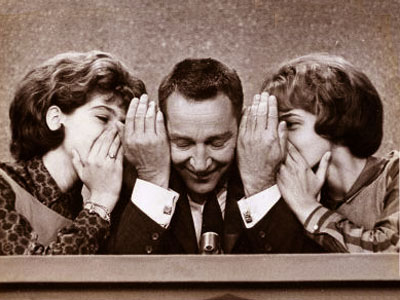
Great example last night on Game Show Network of why Garry Moore was maybe the best TV host ever, at least for that kind of show. The rerun was I've Got A Secret for January 14, 1959, back when the show was broadcast live. The second guest was a gent named Jack Mosely (sp?) whose secret was that using only his own lung power, he could inflate an inner tube until it burst. Naturally, he had to demonstrate this…but when he did, it took a lot longer than usual. Long past the allotted time for the stunt, Jack was still blowing into the thing, which had expanded to the point where it seemed ready to explode…but didn't.
On and on he went, with the audience getting hysterical — and, even on a black-and-white telecast, you could see that Mosely was turning eleven shades of fuchsia. Through it all, Moore kept up a witty, unscripted running commentary and resisted the shouts of his producer to cut the spot off. Special Guest Andy Griffith was still to follow but obviously, Moore reasoned that they had to play the act out to its pay-off. I suspect he thought — no doubt, correctly — "Not one person in America's going to change channels until that tube goes kablooey!" Instead, when a commercial became mandatory, Moore had Mosely pause and then, following the break, the inner tube inflation resumed, now with Andy G. joining Garry to do play-by-play. The tire finally went bang, knocking Mosely on his ass and prompting an incredible audience ovation. They never got to Griffith's "secret" but so what? It was good, fun live television…and honest.
Silly stuff, of course. But I couldn't help think that it would never happen on a TV show today…and I'm not even certain there's a host who could properly ad-lib and cope with all that spontaneity. It isn't just that we rely too much on precisely-edited videotape. It's that the star and format have to be protected at all times. They have to know exactly what's going to happen and have lines prepped for when it happens…and if it doesn't happen that way, they stop tape or edit. Even on a live program — say, an awards ceremony — any chance of surprise is kept to an utter minimum. Maybe the mania some folks have for watching live, televised police chases is because it's such a novelty to view something other than sports on TV where fate, as opposed to a producer, is in control. With all the "reality" shows around, it's only a matter of time before it dawns on someone that real, effective reality begins with allowing the unexpected to occur.
All It's Cracked Up To Be…
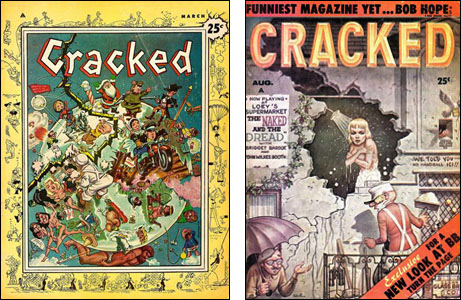
Have we reached the end of the great publishing practice of MAD Magazine knock-offs? Since Bill Gaines's silly periodical began cleaning up on newsstands fifty years ago, rival publishers have been whipping up knock-offs with names like Sick, Blast, Crazy, Up Your Nose, The National Review, etc. (Okay, forget The National Review. It hasn't been funny in years.) But most of the others were…some for a long time, some for a few issues. My favorite of them was Sick, especially in the first issues edited by Joe Simon and written (mostly) by Dee Caruso…but the longest-running of them all was Cracked, which started in 1958 and endured into the new century without, insofar as I could see, ever developing a viewpoint or style of its own. At times, it looked like MAD's refugee camp, employing folks who were on the "outs" with Gaines.
Among many examples: The cover at upper right is from Cracked #10 and was painted by Will Elder…and for a long time, Cracked's lead artist was John Severin, who dated back to MAD #1. When "MAD's Maddest Artist," Don Martin, went away mad in a contract dispute, he found a home in Cracked. So did former MAD associate editor Jerry DeFuccio and one of MAD's most prolific writers, Lou Silverstone, who was an editor at Cracked for a time. (A number of MAD scribes considered it a dandy place to sell their rejects, often employing pen names.)
Cracked did, however, demonstrate enormous endurance. Rumor has it that this was because its publisher was in tight with a powerful distributor. Indeed, the magazine managed some incredible feats of penetration, even getting into that most coveted of outlets, airport gift shops. Last year at this time, it was the last surviving MAD doppelganger…but it's gone through a change of owners and some rough times. At last report, it had been more than six months since an issue materialized, though the publisher is telling contributors that this is a temporary condition and that they will also receive money they have long been owed. I hope so…but the two likeliest indicators of Death in magazine publishing are a suspension of publication and not paying your contributors. If it's history, it will be a sad end to a glorious tradition.
Attention, Frank Welker!
This evening at 11:30 PM, KFTR — a Spanish language TV station based in Los Angeles and broadcasting on Channel 46 — is running How to Frame a Figg, the 1971 movie in which you co-starred with Don Knotts. Let's see how you like being dubbed for a change.
It Figures

As mentioned here recently, Dark Horse Comics is issuing a wonderful series called Classic Comic Characters. Each month, you can buy a couple new figurines of the players from some famous newspaper strip. (A good, honest place to order them is www.budplant.com.) The little statues are issued in limited editions and a few months ago, they came out with Albert the Alligator, reptilian star of Walt Kelly's immortal Pogo. In June, you'll be able to purchase Pogo Possum, hisself. The pic at left was taken last evening on my breakfast table, placing the Pogo prototype alongside a finished Albert. Don't they look great together?
This is because of the expert sculpture work done by the folks at Yoe! Studios but also because these were supervised by my best friend — and another of Walt's great creations — Carolyn Kelly.
I love it when a piece of merchandise perfectly captures the way a character oughta look. Back in my Hanna-Barbera days, I lived in a state of perpetual argument with certain folks in the marketing division who didn't seem to know what Yogi Bear and Fred Flintstone looked like…or, if they did, they didn't care if the toys and t-shirts and lunch boxes matched up. One of the joys of working for years with Jim Davis on Garfield was that it didn't matter to Jim how much it cost, the cat was going to look right. I once saw him kill, without flinching, a $100,000+ deal because the manufacturer couldn't get the lasagna-loving feline to look the way he oughta. Carolyn has been no less strident about getting her father's characters the way he drew them. Would that more people who were in charge of great characters were as diligent and knowledgeable.
See Ya, CBG!
Thanks to Maggie Thompson, editor of Comics Buyers Guide, for her words about me in the issue I just received, which contains my final column for that publication. I must correct one thing: The column that I did when that newspaper started was not in the first issue. I recall it being in about the sixth or seventh…but it was definitely not the first. (I'd correct some of the other nice things she said but I respect Maggie far too much to disagree with her…)
And just so we're all clear on this: My reasons for leaving CBG had to do with the business side of the operation, not with Ms. Thompson, who is a saint. She's a lot like Mother Teresa except that Mother Teresa had the wisdom and compassion not to move my commas.
Fantastic Find
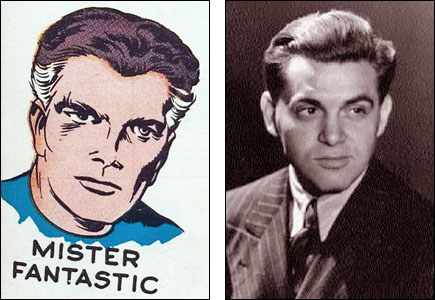
It's funny how something can be staring you right in the face for years and years…and suddenly, one day, you notice that which you should have noticed long before. It's been there all along but somehow, you just didn't notice it. If you click on the illo above, you'll see a reproduction of the front of Fantastic Four #7, published by the then-blossoming Marvel Comics Group way back in 1962. It has an interesting but not spectacular cover which I'd looked at dozens of times over the years without spotting that which I recently spotted. Actually, there are several interesting things about this cover.
One is that, a week or three ago, my friend Will Murray pointed out to me — and I concurred with — his theory that Jack Kirby actually inked this cover. Jack almost never inked at Marvel and a few weeks ago, if you'd asked me if he'd ever inked any Fantastic Four covers, I'd have said, "Certainly not." But this one sure looks like it was. Joe Sinnott inked the insides of #5 and was supposed to be the regular embellisher thereafter but, a page or two into #6, he suddenly found himself buried in deadlines and he turned the issue back. Dick Ayers finished #6 and took over from there on. Apparently, in the shuffle, it was necessary to have someone else ink this cover and Jack wound up doing it. (As a general rule of thumb, the cover to an issue was finished around the same time as the insides of the previous issue.)
Will further notes that this cover probably also shows us the way Jack "saw" The Thing at the time — the way he was pencilling ol' Ben Grimm. The odd texture of the character's epidermis changed a lot as different artists inked Kirby's pencils, though they all seem to have made him less claylike and more segmented than Jack intended. Eventually though — and perhaps to some extent because of the inkers — Jack began to pencil the character less claylike and more segmented.
But neither of these is as interesting to me as this: All those of you who ever met Jack, take a close look at the drawing of Mr. Fantastic. Stare at it for a few seconds. I did…and I was amazed that I'd never before noticed how much the character looks like Jack — especially, Jack as he must have looked around 1962. In fact, the more I looked at it, the more it looked like him. (I met Kirby in '69 so perhaps it looks more like him to me than it does to those of you who met him later, or only saw later photos.) I always knew he drew himself into most of his stories — emotionally, if not visually — and, of course, there are blatant autobiographical elements to The Thing, Nick Fury and any other character who was ever caught puffing on a cigar. It was no secret that Jack identified with most of his recurring heroes but I suddenly found myself saying, "My God…how could I never have noticed before how much Reed "Mr. Fantastic" Richards looks like Jack?" And now that I've made that connection, I doubt I'll ever be able to shake it.
Briefly Noted…
Chanteuse Extraordinaire Shelly Goldstein notes that we're seeing a lot of articles and interviews to celebrate the 25th anniversary of the landmark TV mini-series, Roots. They're trotting out Ed Asner and Levar Burton and Ben Vereen and most of the surviving actors…but you notice which star they haven't interviewed? Whose name isn't even mentioned? Give you a hint: His first two initials are "O" and "J."
Stupid Enron Tricks
An Enron exec who testified this morn seemed to be setting up what may become the official "spin" from the Republican/Enron side of the scandal…namely, that Skilling and Fastow were sharpies who duped poor, innocent Ken Lay and the Board of Directors. Do we think this will sail? No, we do not. For one thing, Skilling and Fastow won't take the fall without bringing others down. For another, Lay has simply been too visible and, as the closest-possible buddy of the Prez, there's too much political advantage to be gained by keeping his feet to the flames.
But another problem — and I'm not kidding about this — is his name. Think about it. A lot of public figures are like a commercial product with a bad name. Once upon a time, one-time advertising man H.R. Haldeman did a marketing survey on his "product," which happened to be Richard Nixon, and concluded that the negative connotations of "nix" were not helpful. That was why in the '72 campaign, they minimized the usage of their candidate's name and plastered "Re-Elect the President" on most bumper stickers. We've seen other public figures since who lost a point or two of favor because of their monikers. It was easier to sell the idea that detective Mark Fuhrman was a racist swine because his name sounded Germanic and recalled the word, "fuhrer." Democrats have less trouble pinning obstruction charges on a guy named Tom DeLay than they might have if the gent had a different surname. And before him, it was easy to sell negatives about a man named "Newt," though — God knows — the guy did plenty to help them.
A guy named Lay is real susceptible to being portrayed as one who screwed a lot of people…especially when linked with a President named Bush and a Veep named Dick. Skilling and Fastow are names that suggest connivers, as well. The former connotes "skill" and "skinning" while the latter could be said to be pulling a "fasto." So the notion that they were the masterminds may have some legs…but Lay's name is just too perfect for him to ever get completely off the hook.
I'm quite serious about this theory, by the way. I call it The Sgt. Bilko Rule.
Stamp Day for Superman
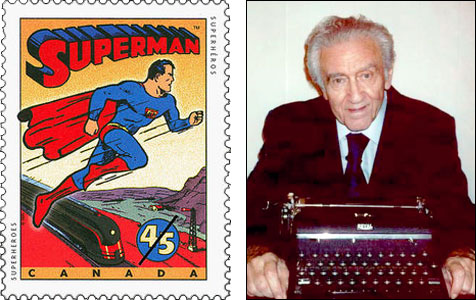
The last few times I saw Jerry Siegel, he was at peace…which was not the case in our first encounters. I met him in 1968, at a time when he not only didn't receive a cent from his co-creation but didn't exist insofar as the history of Superman was concerned. He was wonderful to me but when we got near certain topics, he was justifiably bitter, angry and hurt. Fortunately, that was rectified in increments, commencing in the mid-seventies….and on our last visit, about a month before he died, he seemed like a pretty happy man. One reason, obviously, was that the management of DC had done…well, maybe not all they should have done, but a lot more than earlier regimes. Thanks to some large-hearted, wise and fair folks, the credit for Jerry and his partner, Joe Shuster, had been restored to their work, and they'd received pensions and other financial considerations.
Jerry was also receiving honors that meant a lot to him — at the time, a lovely letter from President Clinton and the issuance of a Superman postage stamp in Canada. (Shuster was of Canadian origin.) Jerry had the note and a prototype of the stamp framed side-by-side on a small table next to his favorite chair in the living room…and that's how I remember Jerry. He was sitting in an easy chair, without a trace of anger about him, looking at the framed items and smiling. Tonight, searching the Internet for info on something else, I came across a picture of the stamp and I thought of that evening.
If you're interested in reading up on the history of Superman, there are some wonderful articles and artifacts posted at www.superman.nu.
That's Our Hitler!
The first national tour of The Producers kicks off in Pittsburgh on September 12. They've been holding auditions and what follows is the "breakdown." That's Show Biz for a list of roles to be filled and a brief description of each. For some reason, it lists Bialystock and Bloom, though it's unlikely those parts would go to someone who showed up for an open call.
Seeking — Max Bialystock: 40s-50s, leading role, must sing reasonably well and, most importantly, be a world-class comic actor, brash, fast-talking, pushy, a once-successful Broadway producer, now down on his luck, New York-born and bred, Jewish, shrewd, intelligent, extroverted and a dirty old man; Leopold Bloom: 30s-40s, leading role, must sing reasonably well and be a brilliant comic actor, faceless minor accountant, has lived a life in which virtually nothing has ever happened to him, like Bialystock, New York-born and bred, Jewish, immensely likable loser, a caterpillar who turns into a butterfly during the musical, must be able to move or dance very well; Ulla: 20s-30s, sexy young woman, must be sensationally good-looking, tall (must be at least 5'9"), with a breath-taking figure, belter and dancer who can fake an endearing Swedish accent; Franz Lebkind: 40s-50s, must sing and move well, must also be a very skilled comic actor, wild-eyed psychotic of German descent, born and raised in Milwaukee, but under the insane belief he served under Hitler as a soldier of the Third Reich, playwright, author of "Springtime for Hitler"; Roger De Bris: early 50s, one-time chorus dancer who became an unsuccessful Broadway director-choreographer, very minty, very egotistical, very funny, like the other male principals, has to be a first-class singer and mover as well as an accomplished comic actor; Carmen Gia: 20s-40s, Roger's flamboyantly gay as a goose assistant, good comic actor, must sing reasonably well.
They spelled a couple of the characters' names wrong but otherwise, don't you love the descriptions? Since when has Franz been born in Milwaukee? And how can someone be "flamboyantly gay as a goose assistant?"
Big "W" News

There's some exciting news for fans of It's A Mad, Mad, Mad, Mad World in The Wall Street Journal this morning. Unfortunately, it requires an on-line subscription to read it so I can't link you to it. But since a nice POVonline reader sent me a copy, I can summarize it for you…
Basically, a gent named Richard A. Harris, who runs a film preservation company in New York, has been tracking down lost footage of the film for years and now believes he's missing only nine minutes of picture and about four minutes of soundtrack. That's not the whole film but it's a good chunk of the 33 or so minutes that were trimmed out a few weeks after the film's 1963 release. Pieces have been located all over the globe but a big find came when a construction worker helped him locate reels of soundtrack that had been stored in a warehouse in Paterson, New Jersey. Here's one excerpt from the article…
Mr. Harris agreed to listen to Mr. Kroeper's sound tracks. The first few were authentic but had nothing on them that wasn't in the shortened version. Then, right where the film's 18th reel should have ended, Mr. Harris heard something unexpected: a phone ringing. He held his breath. A voice said, "Hello?" It was Buster Keaton's growly baritone. On the other end of the line was the voice of Spencer Tracy: "Jimmy?" His hopes rising, Mr. Harris dug through the boxes. He found a reel marked "16" and quickly threaded it onto the player. There was silence, then a series of police radio calls describing a chaotic car chase. They had found one of the movie's oddest artifacts — the entr'acte audio track played during intermission. Only people who saw the film's earliest engagements ever heard that.
As one who saw the film's earliest engagement, allow me to translate: There's a scene still in the movie where Culpepper (Tracy) says he wants an ice cream sundae. Then the following is cut — and remember, I'm telling you this from memory and I was eleven when I saw this: Tracy goes to a Baskin-Robbins shop for some basic product placement and few notes of a song called "31 Flavors" that was being plugged via the movie. He gets his sundae, goes to a phone booth in the back and places a call to Jimmy the Crook (Keaton) to discuss how he wants to get away on Jimmy's boat. As I recall, the conversation took place in split screen and was ambiguous in that it didn't quite tip that Culpepper was going to scram with the $350,000…though when he did later, it seemed a bit less surprising. Anyway, that whole scene has been missing since the end of '63 and now someone has at least located the audio. It was the only time that the man who was perhaps America's greatest dramatic actor worked with the gent who was maybe the greatest comic actor.
The reference to the entr'acte is also intriguing. When I first worked with actor and voice legend Lennie Weinrib, I startled him by telling him I'd recognized his voice in It's a Mad, Mad, Mad, Mad World. Lennie did a couple of the voices of policemen heard on the radio and redubbed a few stunt players and other bits of dialogue. He was never billed in any way but I nailed him. Anyway, he told me that he'd also recorded a whole batch of police calls that were played during the intermission at theaters that ran the long version. I didn't remember that at all. (Mr. Weinrib tells me he checks this site every few days. Hey, Lennie! Looks like they found your performance!)
The search for footage is still going on and there are, as yet, no plans to spring for the expense of a full, digital restoration. But even this much news is worth a few huzzahs and a lot of hopeful grins.
Chad Grothkopf, R.I.P.
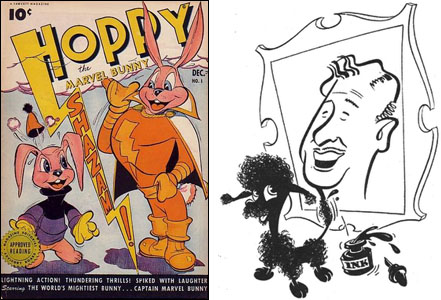
One of comics' veteran artists, Charles "Chad" Grothkopf, passed away on January 25 at the age of 88. He was best known as the creator and illustrator of Hoppy the Marvel Bunny, the funny animal version of the immortal Captain Marvel…but Chad — as he signed most of his work — actually did a lot of work in the adventure category. He drew Johnny Quick, Sandman and other super-heroes for DC in the early forties. (Contrary to popular belief, it was not Simon and Kirby who designed Sandman's yellow and blue costume when they took over the strip. That was done by Chad, who had preceded them.) For most of that decade however, Chad specialized in funny animal comics, producing hundreds out of a studio wherein he also supervised other artists. He later dabbled in newspaper strips, including a long stint on the Howdy Doody feature, and became a pioneer in TV animation.
He worked extensively in advertising and commercial art and, in recent years, had been been a frequent guest at comic conventions. He was a nice man and a very important figure in the history of not one but several fields.
TiVo Troubles
The folks at The Tonight Show did something that was probably not very smart. In an attempt to tie this week's shows in to the Olympics, their program has been renamed The Olympic Tonight Show. Cute…but it means that a TiVo that's been programmed to record The Tonight Show won't record Jay. That'll cost 'em at least a few viewers.
I really like my TiVos (I have two) and they've completely changed the way I watch TV and even the way I live. I no longer have to think about taping my favorite shows when I go out — unless, of course, they've been dumb enough to change their names for a week — and I am now more apt to record, and therefore watch shows that are aired in the middle of the night. I watch almost nothing live. When I feel like watching something, I turn on the TV select a show from several dozen that are on the TiVo menu and — poof! — one button-touch later, I'm watching it. The result is a real sensation of me owning and controlling my TV, as opposed to the other way around.
I've been recommending TiVo in my columns since I purchased my first one, long before anyone had heard of the things. If you need more info, go over to www.tivo.com and read up. But if and when you buy one, come back here, click on the Amazon.Com box down below and buy it there and through that link. It probably won't cost any more, might cost less and if you buy it that way, this site gets a little taste.
Frees Sample

I've written a number of articles about great cartoon voice actors like Daws Butler, Mel Blanc, June Foray and Don Messick. Often, e-mails ask where the heck is the in-depth article about the late, great Paul Frees? Surely, he ranks with the others. And he sure does. Trouble is, apart from one brief phone call, I never met Paul Frees. Never had the honor. And while I could rattle off a list of roles and parrot some third-hand anecdotes, I don't know enough to craft the kind of article he deserves. He was an amazing performer, much admired by his co-stars and incessantly coveted by casting directors.
Some others did more famous characters…though Frees's Boris Badenov is one of the great performances ever in animation. (I especially love when Boris would adopt, say, an Irish accent…thereby requiring Frees to do a Russian guy talking with a brogue. June Foray says these things never threw him, not even for a second. The only other comparable feat I can recall was the WB cartoon — I think it was Rabbit Seasoning — in which Mel B. had to do Bugs imitating Daffy, then do Daffy imitating Bugs.)
During his career, Frees occasionally had his agent assemble a demo tape of his work. Every voice actor has one — some have several — and their creation is an art unto itself. The Paul Frees demos are duped and circulated throughout the voice biz and widely considered the best ever. Most of them run 6-7 minutes and one of the top voice agents once said to me, "I am torn on the subject of handing copies of these out to people. On the one hand, I want them to see how wonderful a voice demo can be. On the other hand, Paul Frees was maybe the only human being ever in the field who could sustain a 7-minute demo tape. And I mean that. Mel Blanc in his prime probably couldn't have kept you listening for seven minutes. If one of my clients today brought in a 7-minute demo, I'd kick him out into the street."
So I suppose you're eager to hear one of these legendary demo tapes, right? Well, here's a link to a site that has one you can hear on-line via RealPlayer. I have a couple of other tapes and I'll post them here if there's enough interest.
